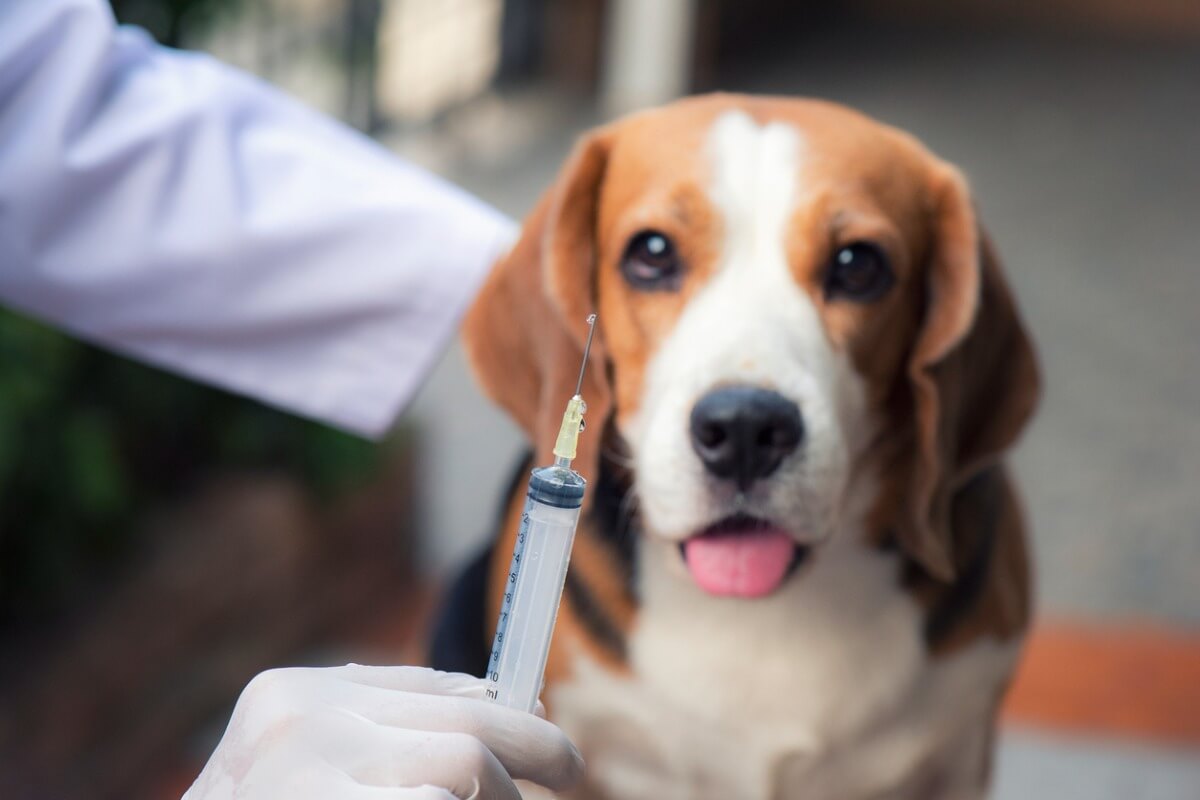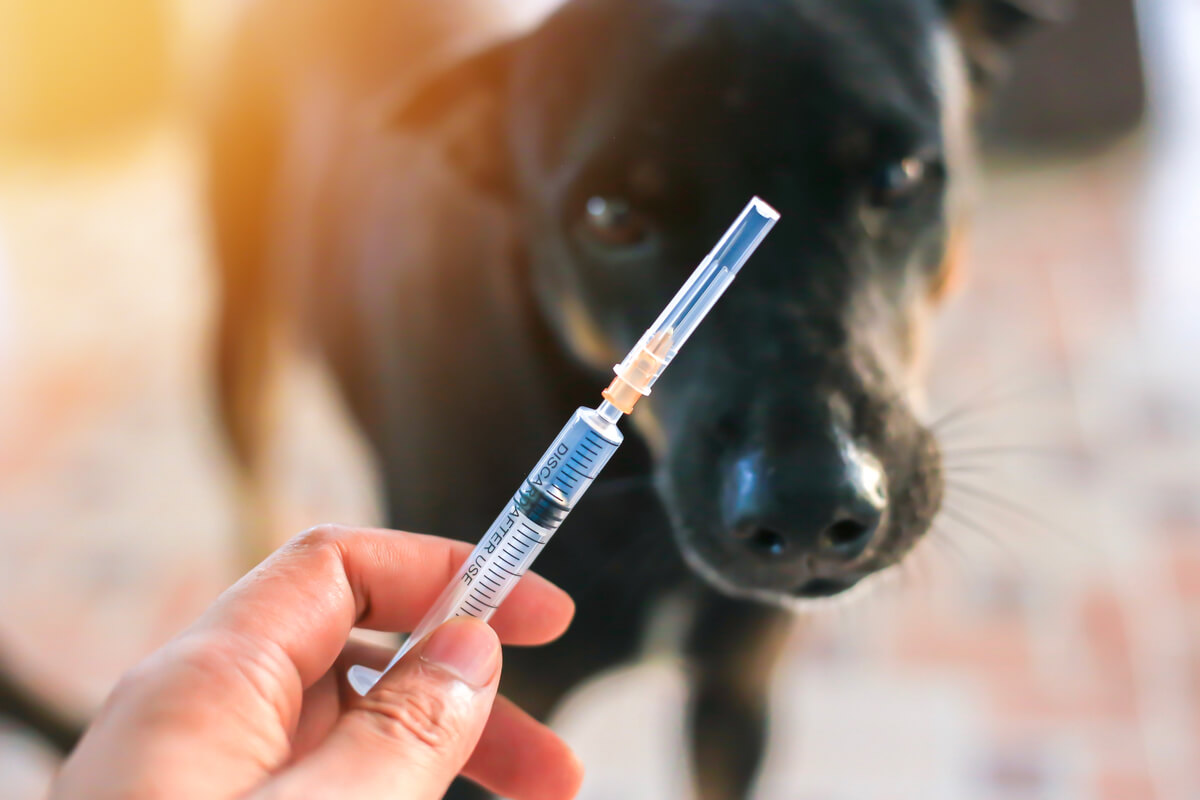What's the DHPP or 5-in-1 Vaccine for Dogs?

As you’ll have surely read, vaccines don’t only protect your pet, but also keep epidemics at bay by preventing other dogs from getting infected. Within this vaccination schedule is included the DHPP or 5-in-1 vaccine for dogs.
As many diseases can be prevented by the vaccine we’re talking about here, some of them were combined into a single formula to protect the dog with a single jab. If you want to know more about it, don’t miss this article!
What’s the 5-in-1 vaccine for dogs?
A vaccine is a preparation that contains attenuated or dead bacteria or viruses, so that when introduced into the animal’s body it helps the defenses to create antibodies without actually developing the disease. In this case, 5 different types of bacteria and viruses are included in the same vaccine, as reflected in its name.
The 5-in-1 vaccine, also called the DHPP vaccine (an acronym given for the diseases it protects against), can be started at 6-8 weeks of age, at the beginning of the puppy’s vaccination schedule. Thereafter, booster doses should be administered once a year.

What diseases does this vaccine protect against?
The 5-in-1 vaccine for dogs includes protection against canine distemper virus, infectious hepatitis, parvovirus, parainfluenza leptospirosis. This isn’t a treatment against the diseases, but a method of prevention, and it’s very advisable never to skip your dog’s vaccinations.
The diseases mentioned in the previous paragraph are very contagious and some of them are fatal, especially for puppies. In the following lines, we’ll tell you more about them.
Canine distemper
Distemper is a viral disease that affects dogs during the first months of age, although sometimes it’s also contracted by adult dogs. It’s highly contagious and is spread through body secretions, such as saliva, although it’s often transmitted by airborne transmission.
Canine distemper virus is very similar to human measles.
Fever is the first symptom to appear, but the respiratory, digestive, skin, and nervous systems are eventually affected. Difficulty breathing, vomiting and diarrhea, convulsions, and muscle spasms are the most common concomitant clinical signs.
Once the dog has been infected, the only possible treatment is symptomatic, as it’s a disease without a cure. Hospitalization may be necessary to prevent the dog from dying from the symptoms.
Canine hepatitis and kennel cough
There are 2 types of adenovirus that affect dogs and are included in the vaccine: canine hepatitis (CAV-1) and kennel cough (CAV-2). Let’s have a look at them:
- Canine infectious hepatitis: This is the more serious of the two conditions. It’s spread through stools and affects the liver. Even if the dog recovers, there may be non-reversible sequelae in the liver, kidney, and eyes.
- Kennel cough: This is airborne and causes respiratory symptoms, fever, and vomiting. It’s mild, but very contagious.
Canine parainfluenza
This virus also causes kennel cough. It’s airborne, just like CAV-2, and creates similar symptoms: a dry cough, runny nose, fever, and vomiting caused by coughing. It’s important not to confuse the condition with canine influenza, although it also affects the respiratory system.
Canine parvovirus
Parvovirus is one of the most feared diseases by puppy owners. It’s serious and often fatal, as it affects the replication of cells in the intestine. It causes bloody diarrhea, vomiting, and subsequent dehydration.
It’s a very resistant virus: it’s able to remain on surfaces for almost a year.
Treatment usually requires hospitalization to keep the animal stable until it recovers. Even so, the puppy is likely to be left with some developmental sequelae. Many of the affected specimens end up dying from the symptoms themselves, especially if the veterinarian isn’t consulted promptly.
Leptospirosis
This disease is caused by a bacterium called Leptospira which is found all over the world. It’s spread by the oral-fecal route and can cause very severe symptoms such as fever, vomiting, bloody diarrhea, and kidney failure.
It’s a zoonotic disease that’s often confused with canine distemper and infectious canine hepatitis. Diagnostic testing and urgent treatment are necessary to prevent the spread of the disease.
How often is the 5-in-1 vaccine for dogs administered?
This combination vaccine is first administered at approximately 6 weeks of age. Thereafter, a booster dose is given every 2-4 weeks until the canine reaches 16 weeks of age. Thereafter, it’s administered annually.
This interval could be up to 3 years. This will depend on the recommendations of the veterinarian and the indications of the vaccine.
Advantages of giving the 5-in-1 vaccination to your dog
There are 2 obvious advantages when availing yourself of this vaccination. The first is that you protect your dog against diseases that could be fatal for them. The other is that, thanks to this combination of vaccines, you only have to visit the vet once and not 5 times.
In addition, the DHPP vaccine is safe for adult dogs and puppies. Although side effects may appear, such as localized pain at the area of the injection or lethargy, these are mild and don’t pose a problem for the animal, as they disappear in a few days.

In short, don’t forget to keep up your dog’s vaccination schedule. You’re not only protecting them – but you’re also helping to prevent diseases from becoming pandemics, preventing other dogs from getting sick, and even helping humans from catching zoonotic diseases, such as rabies.
As you’ll have surely read, vaccines don’t only protect your pet, but also keep epidemics at bay by preventing other dogs from getting infected. Within this vaccination schedule is included the DHPP or 5-in-1 vaccine for dogs.
As many diseases can be prevented by the vaccine we’re talking about here, some of them were combined into a single formula to protect the dog with a single jab. If you want to know more about it, don’t miss this article!
What’s the 5-in-1 vaccine for dogs?
A vaccine is a preparation that contains attenuated or dead bacteria or viruses, so that when introduced into the animal’s body it helps the defenses to create antibodies without actually developing the disease. In this case, 5 different types of bacteria and viruses are included in the same vaccine, as reflected in its name.
The 5-in-1 vaccine, also called the DHPP vaccine (an acronym given for the diseases it protects against), can be started at 6-8 weeks of age, at the beginning of the puppy’s vaccination schedule. Thereafter, booster doses should be administered once a year.

What diseases does this vaccine protect against?
The 5-in-1 vaccine for dogs includes protection against canine distemper virus, infectious hepatitis, parvovirus, parainfluenza leptospirosis. This isn’t a treatment against the diseases, but a method of prevention, and it’s very advisable never to skip your dog’s vaccinations.
The diseases mentioned in the previous paragraph are very contagious and some of them are fatal, especially for puppies. In the following lines, we’ll tell you more about them.
Canine distemper
Distemper is a viral disease that affects dogs during the first months of age, although sometimes it’s also contracted by adult dogs. It’s highly contagious and is spread through body secretions, such as saliva, although it’s often transmitted by airborne transmission.
Canine distemper virus is very similar to human measles.
Fever is the first symptom to appear, but the respiratory, digestive, skin, and nervous systems are eventually affected. Difficulty breathing, vomiting and diarrhea, convulsions, and muscle spasms are the most common concomitant clinical signs.
Once the dog has been infected, the only possible treatment is symptomatic, as it’s a disease without a cure. Hospitalization may be necessary to prevent the dog from dying from the symptoms.
Canine hepatitis and kennel cough
There are 2 types of adenovirus that affect dogs and are included in the vaccine: canine hepatitis (CAV-1) and kennel cough (CAV-2). Let’s have a look at them:
- Canine infectious hepatitis: This is the more serious of the two conditions. It’s spread through stools and affects the liver. Even if the dog recovers, there may be non-reversible sequelae in the liver, kidney, and eyes.
- Kennel cough: This is airborne and causes respiratory symptoms, fever, and vomiting. It’s mild, but very contagious.
Canine parainfluenza
This virus also causes kennel cough. It’s airborne, just like CAV-2, and creates similar symptoms: a dry cough, runny nose, fever, and vomiting caused by coughing. It’s important not to confuse the condition with canine influenza, although it also affects the respiratory system.
Canine parvovirus
Parvovirus is one of the most feared diseases by puppy owners. It’s serious and often fatal, as it affects the replication of cells in the intestine. It causes bloody diarrhea, vomiting, and subsequent dehydration.
It’s a very resistant virus: it’s able to remain on surfaces for almost a year.
Treatment usually requires hospitalization to keep the animal stable until it recovers. Even so, the puppy is likely to be left with some developmental sequelae. Many of the affected specimens end up dying from the symptoms themselves, especially if the veterinarian isn’t consulted promptly.
Leptospirosis
This disease is caused by a bacterium called Leptospira which is found all over the world. It’s spread by the oral-fecal route and can cause very severe symptoms such as fever, vomiting, bloody diarrhea, and kidney failure.
It’s a zoonotic disease that’s often confused with canine distemper and infectious canine hepatitis. Diagnostic testing and urgent treatment are necessary to prevent the spread of the disease.
How often is the 5-in-1 vaccine for dogs administered?
This combination vaccine is first administered at approximately 6 weeks of age. Thereafter, a booster dose is given every 2-4 weeks until the canine reaches 16 weeks of age. Thereafter, it’s administered annually.
This interval could be up to 3 years. This will depend on the recommendations of the veterinarian and the indications of the vaccine.
Advantages of giving the 5-in-1 vaccination to your dog
There are 2 obvious advantages when availing yourself of this vaccination. The first is that you protect your dog against diseases that could be fatal for them. The other is that, thanks to this combination of vaccines, you only have to visit the vet once and not 5 times.
In addition, the DHPP vaccine is safe for adult dogs and puppies. Although side effects may appear, such as localized pain at the area of the injection or lethargy, these are mild and don’t pose a problem for the animal, as they disappear in a few days.

In short, don’t forget to keep up your dog’s vaccination schedule. You’re not only protecting them – but you’re also helping to prevent diseases from becoming pandemics, preventing other dogs from getting sick, and even helping humans from catching zoonotic diseases, such as rabies.
All cited sources were thoroughly reviewed by our team to ensure their quality, reliability, currency, and validity. The bibliography of this article was considered reliable and of academic or scientific accuracy.
- España, E. (2009). Factores asociados a la respuesta inmunitaria de caninos frente a la parvovirosis canina. Gaceta de Ciencias Veterinarias, 14(1), 25-32.
- Aly, N. I., & Salama, Z. T. (2005). Preparation of an inactivated penta cell culture vaccine against canine distemper, canine parvo, canine hepatitis. Journal of Veterinary Medical Research, 15(2), 208-214.
This text is provided for informational purposes only and does not replace consultation with a professional. If in doubt, consult your specialist.








